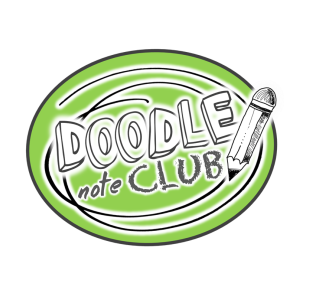
We all routinely encounter “problems” or challenges to overcome, everything from planning a family beach vacation to deciding what to make for dinner. Of course, some problems are undoubtedly more complex than others!
For these complex challenges, there is a fool-proof way to think clearly! (Hint: If you are a club member, you probably already have your students doing this regularly). Be sure to share this information with your students, so they can benefit as well!
Why Doodling is Good for EXPLAINING a Concept or SOLVING a Problem:
Doodling shouldn’t only be used by your students in the classroom! When done the right way doodling can help you and your students solve problems and communicate effectively outside of class.
A book at the top of my “To Read” list is The Back of a Napkin by Dan Roam. In the book, Roam explains the power of drawing out ideas and creating a visual to help us to think clearly and effectively problem-solve and/or communicate.
Dan Roam is an expert in visual thinking, and shares his ideas with big companies, like Microsoft, Wal-Mart, and the US Navy.
He noticed that during strategy meetings with corporate groups, people found it hard to understand each other and there were sometimes miscommunications. He found that when he drew simple pictures to illustrate his ideas, he was able to communicate his ideas more effectively.
“Adding a visual opens things up to us,” says Roam.
According to How Doodling Could Help You Solve Your Biggest Problems, “More than half of our brain is designed to process images, so when drawing is used in tandem with good ol’ talking things out, the fully engaged brain can come up with better solutions and connect with the material on a higher level.”
How to Doodle the Right Way
Brit + Co shared a few great tips to make doodling more effective; I’ve added a few below as well. Now, all you need is a paper and pencil, and you can start doodling with purpose!
Here are the tips on specifically HOW to doodle in a way that boosts your problem solving capabilities!
Keep in Mind your Organizational Preferences.
Do you prefer to think about things in chronological order or maybe in order of importance?
Let’s take making a grocery list, for example. Personally, I prefer to organize my shopping list according to my path throughout the store, (I list out my produce, then bakery, then meats, etc.) Some people prefer organizing by meals, recipes, or maybe even budget.
The point is: Set up your doodles in a way that reflects the way you think about things.
You don’t have to be an artist.
Draw what’s on your mind, not what you think it should look like. You don’t have to draw a perfect stalk of broccoli to represent veggies on your grocery list!
Conveying the thought is more important than creative ability.
Keep it simple.
Keeping it simple relieves a lot of pressure!
Roam recommends starting with circles; next, write names and labels. Then, you can draw arrows to explain how they relate to one another.
Don’t edit yourself.
It’s important to get the whole thought out, don’t restrict the flow of the process.
You have to Start Somewhere
Don’t know where to start? I’ll tell you! Simply, pick up a pencil and paper and start doodling your key words.
I like to start with my main idea in a circle in the middle of the page, and expand the web outwards, getting more and more specific with the topic.
Your goal is to end up with a nice mind map that allows you to:
- See the big picture for yourself
- Analyze a problem / solution
- Show others the concept and share the ideas in a way that makes sense!
What problems are you or your students going to solve using doodling? Leave a comment below!


